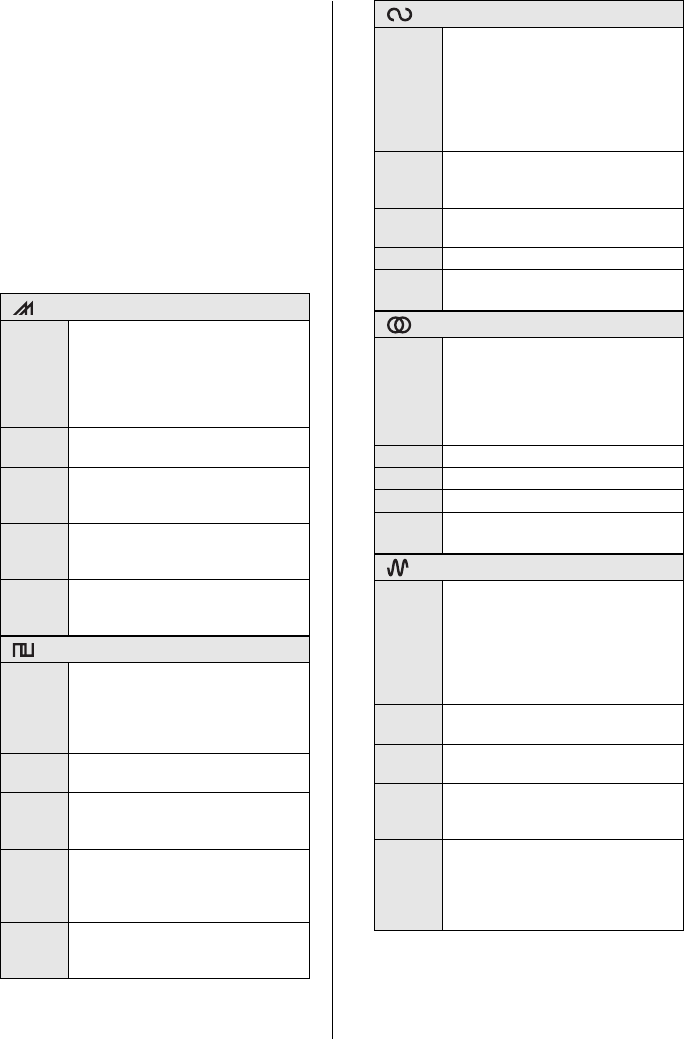
12
reface CS/DX/CP/YC Owner’s Manual
Functions of Front Panel Components
iOSC (Oscillator) section
For setting the oscillator(s). A voice can be
created by using the three sliders in this sec-
tion. In addition, the voice can be further
modified by setting the LFO section’s
[ASSIGN] slider (y-1) to “OSC” and
adjusting its [DEPTH] and [SPEED] sliders.
i-1. [TYPE] slider
i-2. [TEXTURE] slider
i-3. [MOD] (Modulation) slider
*The “LFO (OSC)” rows in the following
tables indicate what can be done when the
LFO section is set to “OSC.”
(Multi-saw)
Descrip-
tion
Produces a basic synthesizer voice
by using sawtooth waves. Multiple
sawtooth waves can be layered to
create thicker voices, or a “sub-oscil-
lator” that plays 1 octave lower can
be added to fatten the sound.
[TEXTURE]
Adds a sub-oscillator to fatten the
sound.
[MOD]
Layers multiple sawtooth waves to
make a thicker, more undulating
sound.
LFO (OSC)
The LFO modulates the oscillator’s
pitch. This does not affect the sub-
oscillator.
Mode of
use
Ideal for the creation of trance
pads, techno basses, and other
similar sounds.
(Pulse)
Descrip-
tion
Produces a basic synthesizer voice
by using square waves. Two
square waves with different pitches
can be layered to make the sound
more complex.
[TEXTURE]
Changes the pitch of the second
square wave.
[MOD]
Changes the pulse width. Raising
the slider produces a distinctive
thinner sound.
LFO (OSC)
The LFO modulates the pulse
width. This makes it possible to
create a distinctive effect known as
“pulse width modulation.”
Mode of
use
Ideal for the creation of leads,
pads, synth basses, and other sim-
ilar sounds.
(Oscillator Sync)
Descrip-
tion
Produces voices having two oscilla-
tors (OSC1 and OSC2), with OSC2
locked in sync with OSC1. Intense
harmonics can be generated by
changing the pitch and tone of
OSC2, making it possible to create
highly distinctive, dazzling sounds.
[TEXTURE]
Changes the pitch and tone of
OSC2. This makes the generated
harmonics mellower.
[MOD]
Sets the degree to which the OSC2
pitch is changed.
LFO (OSC)
The LFO modulates the OSC2 pitch.
Mode of
use
Ideal for lead voices used to play
solos and other similar sounds.
(Ring Modulation)
Descrip-
tion
Produces voices by multiplying the
signals from two oscillators (OSC1
and OSC2). Metallic-sounding
voices with no distinct pitch can be
created by changing the pitches of
the oscillators.
[TEXTURE]
Changes the pitch of OSC1.
[MOD]
Changes the pitch of OSC2.
LFO (OSC)
The LFO modulates the OSC2 pitch.
Mode of
use
Ideal for extreme basses and
sound effects.
(Frequency Modulation)
Descrip-
tion
Produces voices having two oscil-
lators (OSC1 and OSC2), with the
frequency of OSC1 modulated by
OSC2. This makes it possible to
create voices with intense harmon-
ics such as those of the Yamaha
DX7 and other FM synthesizers.
[TEXTURE]
Sets the degree to which modulation
is applied.
[MOD]
Changes the pitch of the modulat-
ing oscillator (OSC2).
LFO (OSC)
The LFO can modulate the degree
to which frequency modulation is
applied.
Mode of
use
Ideal for leads, synth comping
voices, and sound effects. With the
[MOD] slider moved all the way up,
noise and electronic snare drum
sounds can also be created.


















